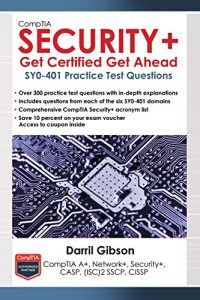CompTIA Security+ SY0-401 Practice Test Questions (Get Certified Get Ahead) includes 307 realistic practice test questions and 274 flash cards all formatted specifically for the Kindle.
If you want to test your readiness for the Security+ (SY0-401) exam and reinforce the important material, this Kindle book is for you.
The book is organized in six chapters matched to the six Security+ domains. Each chapter includes at least three sections:
Some chapters include a fourth section. For example, Chapter 1 includes two tables related to the Network Security domain. One table lists all the relevant ports and protocols you need to use for the Security+ exam and a second table lists the layers of the OSI model along with relevant protocols and devices.
The introduction includes details on the exam to give you an idea of what to expect including a section on performance-based questions and a strategy of how to answer these questions. Additionally, the acronym list at the end of the book provides relevant details on the acronyms referenced in the Security+ exam.
If you want to test your readiness for the Security+ (SY0-401) exam and reinforce the important material, this Kindle book is for you.
The book is organized in six chapters matched to the six Security+ domains. Each chapter includes at least three sections:
- Practice test questions without answers. Created for readers that want to go through all the questions without seeing the correct answers or explanations.
- Practice test questions including answers formatted for the Kindle. One Kindle screen shows the question. When you decide what you think is the correct answer, go to the next Kindle screen to see the correct answer. Each question includes an in-depth explanation so you'll know why the correct answers are correct, and why the incorrect answers are incorrect.
- Flash cards formatted specifically for the Kindle to help reinforce important concepts. One Kindle screen shows a flash card type question and the next Kindle screen shows the answer.
Some chapters include a fourth section. For example, Chapter 1 includes two tables related to the Network Security domain. One table lists all the relevant ports and protocols you need to use for the Security+ exam and a second table lists the layers of the OSI model along with relevant protocols and devices.
The introduction includes details on the exam to give you an idea of what to expect including a section on performance-based questions and a strategy of how to answer these questions. Additionally, the acronym list at the end of the book provides relevant details on the acronyms referenced in the Security+ exam.



